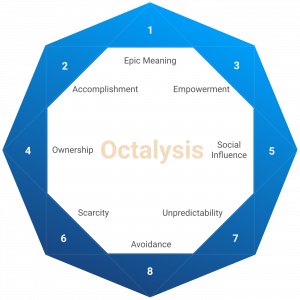
Octalysis
Yu-kai Chou is the creator of the Octalysis framework. Check out his TED talk, or visit the Octalysis group to find out more
The Octalysis framework consists of eight Core Drives (CDs)
1. Epic Meaning & Calling
2. Development & Achievement
3. Empowerment of Creativity & Feedback
4. Ownership & Possession
5. Social Influence & Relatedness
6. Scarcity & Impatience
7. Uncertainty & Curiosity
8. Avoidance & Loss
In Level I Octalysis, any experience is analysed in terms of how strongly it satisfies these drives – on a scale of 1 to 10, and four further levels of the Octalysis methodology allow a deeper analysis of any experience. Analysis creates a ‘graph’ of relative strengths of each of the CDs on an eight-sided diagram.
There is also a tool to help you with mapping experience to the Octalysis framework at Yu-kai’s site.
An overall score can be derived from the sum of the squares of each of the eight CD scores. There are other aspects of the Octalysis model, which can be considered
Other aspects of the model
Black Hat vs White Hat gamification – broadly manipulative vs empowering, but less simplistic as ‘Black Hat’ does not necessarily imply a negative technique or outcome. The White Hat drives are 1,2 and 3 at the top of the Octalysis diagram, while the Black Hat drives are 6,7 and 8 at the bottom. Drives 4 and 5 could be either White or Black Hat, depending on a specific implementation.
Left Brain vs Right Brain – broadly extrinsic vs intrinsic. Yu-Kai does not intend any ‘real’ psychological definition here – left brain / right brain theories are largely being replaced with a much more sensible ‘whole-brain’ view, but this identification is at least easy to remember, not least because the Left Brain drives (2, 4 and 6) are on the left of the diagram and Right Brain (3,5 and 7) on the right. CDs 1 & 8 could be either depending on context and implementation.
Deeper levels of analysis – Level II
At Level II, an experience can be examined not as a whole but as a journey through four stages
- Discovery – The stage between the time that people first hear about your product or experience and when they sign up to try it out.
- Onboarding – This starts once people have signed up and contains all the activities that people carry out to learn how to use your product or experience. They explore tools and techniques and rules, and get to try the basic activities out. When they have learned enough to navigate your experience or use the product in a basic way, this stage ends. This will also be when the reach the early ‘win-states’.
- Scaffolding –During Scaffolding participants will be engaging in the usual activity of your product or experience. This may involve them repeating the same actions again and again, so we need to be sure that motivation is maintained throughout this stage for them to do this.
- Endgame – Once you participants feel that they have experienced everything your experience has to offer at least once, they enter the End Game. Those who remain into this phase will be your ‘veterans’ and they must find enough motivation to continue interacting with your experience, even though it is now familiar to them.
Octalysis analysis can be used to examine how well the eight drives are satisfied during the four stages.
For an example see Ludogogy’s application of Octalysis to a Sustainability Learning Programme.
Level III
Level III further interrogates an experience by factoring in ‘Player Types’ Octalysis does not suggest its own player types, as there are plenty of other experts working on this area. The particular ‘player type’ model which is appropriate depends on your target audience. If creating a game, it might be appropriate to use Richard Bartle’s four player types, which came out of his research into Multi Use Dungeons (MUDs) in the 1970s. For gamification in a work-based setting, it is more appropriate to use Andrzej Marczewski’s six player types, developed from Bartle’s work, but specifically looking at motivations in enterprise workplace settings.
Level III combines stages and player types to give a matrix of graphs for all player types during each of the four phases.


Be the first to comment